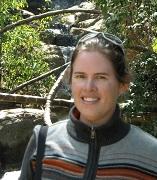Get to know SESYNC's newest postdoc Kelly Jones!

Name: Kelly Jones
Ph.D.: Nursing
Hometown: Colorado Springs, CO
SESYNC Project: Climate and Health: What is the role of the neighborhood environment in children’s respiratory health outcomes?
How would you describe your primary field of study?
Public Health Nursing
What are the broad questions you are interested in studying?
More than half of the global population lives in urbanized areas, and the number of urban residents will continue to grow. How do the choices that we have made and continue to make about building those cities affect the health of the populations that live in and around them? What does it take to build cities that are dynamic, resilient, and sustainable and support vibrant and healthy populations? What changes to existing urban places could best support cities, the spaces they occupy, and the people that live in them?
What inspired you to choose this field of study?
As a nurse, I am interested in helping people to live well. Cities provide so many wonderful opportunities, but they bring with them their own set of challenges. If nurses can help drive the conversation around urban development to include human health and well-being as a primary and non-negotiable aim, then the opportunities around economic development, environmental conservation, and creative growth become more, not less.
Can you briefly describe your proposed SESYNC postdoctoral project?
At SESYNC I will be looking at the role of the physical neighborhood environment in children’s respiratory health outcomes in Washington, DC. In the course of growing, learning, and playing, kids are exposed to any number of potentially harmful toxins and pollutants that could have detrimental health effects. Their neighborhoods may have features that either exacerbate or moderate these exposures. Spatially explicit models that include information both from the local neighborhood and the child’s health history may give us a better idea about what specific policies aimed at modifiable environmental features can best address issues associated with children’s respiratory health.
A key goal when designing solutions for children is to not inhibit their ability to run, play, jump, swing, and in a myriad of other ways enjoy their physical, social, and emotional experiences of the world. Policies that ameliorate environmental concerns might address both concerns about the ecosystem as well as ensure that children are able to spend time outside with friends and family.
Why is SESYNC the right place to undertake this research?
Interactions between humans and environments are complex, with many moving parts and feedbacks. The expertise that SESYNC has in house, as well as the broad research support, will allow me to reach across traditional disciplinary boundaries to model the complexities of both the human and environmental systems, as well as their dynamic interactions. It is rare to find such intense support for such a wide range of research questions and analytic techniques.
What are you reading right now?
A wonderful and entertaining book by Richard Sennett called Building and Dwelling: Ethics for the City that challenges the reader to really think about the urban spaces she and others are inhabiting and moving through while building lives that are rich, varied, and integrated.